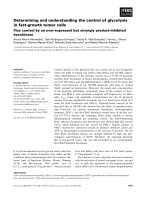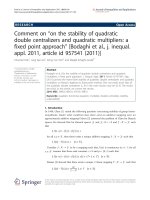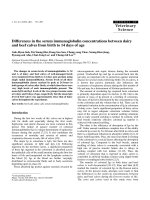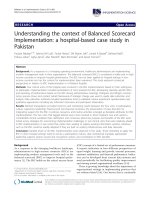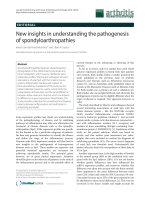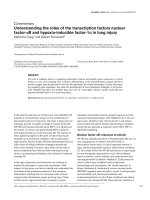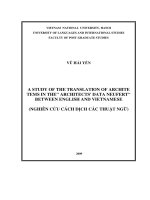Employing face theory in understanding the linguistic differences in the concept of politeness between english and vietnamese m a
Bạn đang xem bản rút gọn của tài liệu. Xem và tải ngay bản đầy đủ của tài liệu tại đây (3.23 MB, 168 trang )
VIETNAM NATIONAL UNIVERSITY- HO CHI MINH CITY
UNIVERSITY OF SOCIAL SCIENCES AND HUMANITIES
FACULTY OF ENGLISH LINGUISTICS AND LITERATURE
---------
EMPLOYING FACE THEORY IN UNDERSTANDING THE
LINGUISTIC DIFFERENCES IN THE CONCEPT OF
POLITENESS BETWEEN ENGLISH AND VIETNAMESE
NGUYỄN XUÂN TRIỀU
A thesis submitted to the Faculty of English Linguistics and Literature in partial
fulfilment of the Master’s degree in TESOL
Supervised by
LÊ HOÀNG DŨNG, Ph.D.
HO CHI MINH CITY, FEBRUARY 12, 2015.
ACKNOWLEDGEMENTS
Many people deserve my thanks for helping me at various stages of this work,
either at the professional or emotional level.
Firstly, I would like to thank my parents for their enduring of my long
sedentariness during the writing of this thesis.
I want to send my deepest gratitude to Professor Phuong Thien for her great help
with finding the subjects for the research. I also want to express my gratitude to
Dr. Dennis F. Berg, Emeritus Professor from California State University –
Fullerton (CSUF) for his insightful comments on my questionnaire. He helped
me correcting both the wording and the layout of the instrument to make it
more appropriate for eliciting data.
I want to express my deep gratitude to statistician Nguyen Hoang Vinh for his
several weeks of sorting data and running the tests and also for his great help in
instructing me how to interpret the results. I still own him a big meal at an
expensive restaurant as promised!
Finally, this thesis would not be possible without the encouragement and
meticulous guidance of Dr. Le Hoang Dung. I initially aimed for a lower target
but Mr. Hoang Dung was the one who encouraged me to pursue higher goal in
expanding and renewing my thesis. He literally took my research to a whole new
level. I am indebted to him not only professionally but also in life lessons. I still
remembered his skilful demonstration in splitting the fish on the dinner table
one night of the field trip and his many pieces of advice for me. He is not only
my thesis supervisor but also my mentor.
THANK YOU!
CERTIFICATE OF ORIGINALITY
This is to certify that the thesis entitled Employing Face Theory In
Understanding The Linguistic Differences In The Concept Of
Politeness Between English and Vietnamese submitted by Nguyễn
Xuân Triều is a record of bona fide work carried out under the
guidance of Lê Hoàng Dũng, Ph.D. and the supervision at the Faculty
of English Linguistics and Literature, University of Social Sciences
and Humanities.
The thesis contains no materials previously published or written by
others except where due acknowledgment. All contributions made to
the thesis are also explicitly acknowledged.
Ho Chi Minh City, 2015
NGUYỄN XUÂN TRIỀU
TABLE OF CONTENTS
Title page
Acknowledgements
Certificate of originality
Table of contents
List of tables and figures
Abstract
CHAPTER 1. INTRODUCTION----------------------------------------------------1
1.1. Introduction ------------------------------------------------------------------1
1.2. Thesis Statements ------------------------------------------------------------2
1.2.1. Rationale of the study -------------------------------------------------2
1.2.2. Research objectives----------------------------------------------------4
1.2.3. Research questions ----------------------------------------------------5
1.3. Methodology -----------------------------------------------------------------7
1.4. Theoretical and practical significance---------------------------------------7
1.5. Thesis structure --------------------------------------------------------------9
CHAPTER 2. LITERATURE REVIEW--------------------------------------------10
2.1. Preparation for a newborn: foundational theory of Austin ---------------10
2.2. Grice’s cooperative principles -----------------------------------------------12
2.3. Lakoff ’s pragmatic competence ---------------------------------------------14
2.4. Leech’s general pragmatics ---------------------------------------------------18
2.5. Brown and Levinson’s theory of politeness ---------------------------------24
2.5.1. Assumptions -----------------------------------------------------------24
2.5.1.1. Assumptions 1 -------------------------------------------------24
2.5.1.2. Assumptions 2 -------------------------------------------------26
2.5.1.3. Assumptions 3 -------------------------------------------------27
2.5.1.4. Assumptions 4 -------------------------------------------------27
2.5.1.5. Assumptions 5 -------------------------------------------------28
2.5.1.5.1. Kinds of face threatened ------------------------------28
2.5.1.5.2. Threats to H’s face versus threats to S’s---------------30
2.5.2. Strategies for doing FTAs ---------------------------------------------31
2.5.3. Factors influencing the choice of strategies --------------------------35
2.5.4. Politeness strategies ---------------------------------------------------36
2.5.4.1. Positive politeness ---------------------------------------------36
2.5.4.1.1. Claim common ground -------------------------------36
2.5.4.1.2. Convey that S and H are cooperators ----------------38
2.5.4.1.3. Fulfill H’s wants for some X --------------------------38
2.5.4.2. Negative politeness --------------------------------------------38
2.5.4.2.1. Be indirect ---------------------------------------------38
2.5.4.2.2. Don’t presume/assume --------------------------------38
2.5.4.2.3. Don’t coerce H ----------------------------------------38
2.5.4.2.4. Communicate S’s want not to impinge on H --------39
2.5.4.2.5. Redress other wants of H’s ----------------------------40
2.5.5. Criticism of Brown and Levinson’s face-saving theory -------------40
2.5.5.1. Rationality -----------------------------------------------------40
2.5.5.2. The individualistic and Eurocentric nature of the theory --42
2.6. Literature review of instrument: Discourse Completion Test (DCT) -----46
2.6.1. Discourse Completion Test (DCT) ----------------------------------46
2.6.2. Arguments for DCT --------------------------------------------------46
2.6.2.1. Weaknesses ----------------------------------------------------46
2.6.2.2. Strengths -------------------------------------------------------48
2.6.2.2.1. The observer’s paradox--------------------------------48
2.6.2.2.2. Advantages of Discourse Completion test -----------50
2.7. Conclusion -------------------------------------------------------------------54
CHAPTER 3. METHODOLOGY ---------------------------------------------------55
3.1. Informant community -------------------------------------------------------55
3.2. Instrument --------------------------------------------------------------------58
3.2.1. Structure of the instrument-------------------------------------------58
3.2.2. Sample of actual instrument (English version) ----------------------63
3.3. Pilot test ----------------------------------------------------------------------63
3.3.1. Purposes ---------------------------------------------------------------63
3.3.2. Instrument and participants of pilot test ----------------------------64
3.3.3. Modifications ----------------------------------------------------------66
3.4. Procedure of data collection -------------------------------------------------67
3.4.1. Procedure of instrument application --------------------------------67
3.4.1.1. Vietnamese group ---------------------------------------------67
3.4.1.2. American group -----------------------------------------------69
3.5. Coding ------------------------------------------------------------------------69
3.6. Procedure of data analysis ---------------------------------------------------71
3.7. Conclusion -------------------------------------------------------------------72
CHAPTER 4. DATA ANALYSIS AND DISCUSSION OF RESULTS----73
4.1. Data analysis------------------------------------------------------------------73
4.1.1. General inter-group differences --------------------------------------73
4.1.2. Strategy-based inter-group differences ------------------------------78
4.1.3. Correlation between three parameters and the use of linguistic
strategies ----------------------------------------------------------------84
4.2. Answers to research questions ----------------------------------------------88
4.2.1. Research question 1 ---------------------------------------------------88
4.2.2. Research question 2 ---------------------------------------------------89
4.3. Summary ---------------------------------------------------------------------90
CHAPTER 5. CONCLUSION--------------------------------------------------------94
5.1. Research précis ---------------------------------------------------------------94
5.2. Some pedagogical implications ---------------------------------------------97
5.3. Limitations and recommendations for further study ----------------------97
REFERENCES------------------------------------------------------------------------------98
APPENDIX----------------------------------------------------------------------------------104
Appx 1. Questionnaire. Pilot. American --------------------------------------104
Appx 2. Questionnaire. Pilot. Vietnamese -------------------------------------111
Appx 3. Questionnaire. American ---------------------------------------------117
Appx 4. Questionnaire. Vietnamese -------------------------------------------122
Appx 5. List of variable for coding ---------------------------------------------127
Appx 6. Sample answers --------------------------------------------------------130
Appx 7. The case of hedging----------------------------------------------------152
Appx 8. The case of salutations ------------------------------------------------155
LIST OF TABLES AND FIGURES
CHAPTER 1
Table 1.1. Summary of research’s rationales ........................................................4
Table 1.2. Summary of research’s objectives and research questions ............... 7
CHAPTER 2
Table 2.1. Lakoff ’s Politeness types .......................................................................18
Table 2.2. Summary of literature review .............................................................. 23
Table 2.3. Summary of Brown and Levinson’s face theory ................................ 45
Table 2.4. Weaknesses and Strengths of DCT and the Research Focus ...........53
Figure 2.1. Lakoff ’s Pragmatic Competence ........................................................16
Figure 2.2. Leech’s General Pragmatics ................................................................ 19
Figure 2.3. Leech’s Scheme of Rhetoric ................................................................ 20
Figure 2.4. Negative and Positive Politeness ........................................................26
Figure 2.5. Strategies for doing FTAs ................................................................... 32
CHAPTER 3
Table 3.1. Foreign Group respondents .................................................................
54
Table 3.2. Vietnamese Group respondents .......................................................... 55
Table 3.3. Combinations of explanatory variables.............................................60
Table 3.4. Inventory of situations according to contextual and sociological
variables .........................................................................................................61
Table 3.5. Stage 1 of Pilot Test ............................................................................... 63
Table 3.6. Stage 2 of Pilot Test ............................................................................... 65
Table 3.7. Questionnaire Delivery .......................................................................67
Table 3.8. Process of Coding ................................................................................. 69
Table 3.9. Summary of Data Analysis ..................................................................70
CHAPTER 4
Table 4.1. Chi-square test for general inter-group differences.......................... 71
Table 4.2. Mean differences in the use of politeness strategies between
American and Vietnamese group ................................................................. 76
Table 4.3. ANOVA test for Mean differences in the use of politeness strategies
between American and Vietnamese group .................................................. 78
Table 4.4. Pearson Correlation test between Socio-parameters and choices of
politeness strategies- American Group ........................................................ 82
Table 4.5. Pearson Correlation test between Socio-parameters and choices of
politeness strategies- Vietnamese Group ..................................................... 84
Table 4.6. Summary of research questions and answers ....................................88
Table 4.7. Summary of conclusions from statistical tests .................................. 91
CHAPTER 5
Table 5.1. Comparison between Vietnamese and American hedges ............... 94
ABSTRACT
This investigation is of a cross-cultural nature. It aims at identifying the
similarities and/or differences in the concept of politeness between two speech
communities namely Vietnamese and American. The principal theoretical
framework used in the research is the face-saving theory proposed by Brown and
Levinson (1989). Face, as described by Brown and Levinson, is the manifestation
of two basic needs which each person, as a potential communicator, has. They
are (1) the need of approval in communication and (2) the desire for freedom of
action and freedom from imposition. Depending on various cultural factors, one
speech community will choose to pursue more actively one type of face over the
other. This study uses DCT questionnaire as the main instrument of data
elicitation. Twelve situations are designed with the built-in of various
sociocultural explanatory variables namely Social Power (SP), Social Distance
(SD) and Ranking of imposition (R). Responses are classified using the coding
scheme prescribed by Brown and Levinson. Results have shown that there are
high levels of cross-cultural differences in the perception of face between two
communities. The Vietnamese seem to be more motivated by the desire for
harmony in communicative events. Disagreements are generally avoided as they
can constitute a face-losing situation for both parties. Intimacy, friendship and
camaraderie are commonly emphasised by the Vietnamese. At the same time, the
American counterparts show a tendency of being oriented by the respect for
personal freedom and/or autonomy. They generally avoid those acts that can
infringe on the others’ freedom of action. An imposition-free communicative
environment is usually desired among the Americans. Based on these findings,
some pedagogical implications are suggested which are concerned primarily
with the differences in the concept of face. Some examples on the hedging
strategies of both the Vietnamese and the Americans as well as the manner of
conducting salutations are provided to support the arguments.
Key words: politeness, face, face theory, positive face, negative face, Brown and
Levinson.
CHAPTER 1. INTRODUCTION
1.1. Introduction
Circa late 1960s and early 1970s, the world of linguistics witnessed the
germination of a new branch from the family tree. Being born as a descendant of
pragmatics and sociolinguistics, this newcomer was destined to solve the secrets
of human interacting mechanism. The newborn was given the name linguistic
politeness.
The history of merely more than 40 years seems deceptively short and strikingly
paradoxical especially when one takes into consideration the current burgeoning
development of this branch. Day after day, literature titles on linguistic politeness
multiply by geometric progression in magazines, journals, symposiums, etc. and
there is no sign that this will ever stop.
Politeness pragmaticians’ concerns are ubiquitous. They are found across various
aspects of human’s communication, from patterns of speech, rules of
conversation, polite linguistic structures to the more macroscopic question of
how people can successfully converse when they mean something quite different
from what is actually said - as in the case of indirect speech acts.
Myriads of theoretical models have been built, hundreds of theories put forward
and thousands of articles published. None of them seems adequate to satisfy the
perpetual thirst of understanding human communication. One researcher after
another, all carry out the same routine task, criticizing the predecessors and
being criticized by those coming after.
Thus, anyone who is ambitious enough to set himself into the quest for a panacea
of linguistic politeness would immediately find him bogged down in the middle
of nowhere. The goal of which is a chimera. Instead of looking for a skeleton key,
researchers should choose for themselves a theory and subsequently become its
adherent; or they can even go further in combining and reconciling more than
one theories in the hope that strengths of ones could somehow make up for
1
weaknesses of the others. The researcher of this research chooses to stick to the
most influential theory of politeness, the one which is widely applied for crosscultural studies due to its static nature, the one which was developed by Brown
and Levinson. It is The Face Theory.
1.2. Thesis Statements
An exploration into the vast territory and yet a misty terrene of pragmatics on
which ground unanimous agreements amongst pioneers and their descendants
are the last thing one can expect always requires an exercise of thorough
premeditation. The subsequent sections are an attempt to make lucid those
principles underpinning the argument to be presented in the thesis.
1.2.1. Rationale of the study
Successful performance of communicative events is the foremost goal of any
language learners. But on which ground and based on what criteria can a piece
of communication be assessed as successful? Could it merely be a matter of lexis,
syntax and appropriate application of grammatical rules? The scope of this view
is , needless to say, monochromatic and does not encapsulate the sophisticated
essence of the mosaic communication picture. Let us look at the following
instance:
Many foreigners feel uncomfortable when Vietnamese people seem to care too
much about what is going on with them. They ask questions, expect you to explain,
even tell you to do this or not to do that, interfere to some extent in your “private
space”. If possible, try to take it in stride […] For example, my twenty-one-year-old
Danish friend got very annoyed when her Vietnamese boss (a forty-five-year-old
woman) told her to…go to bed early, not let strange Vietnamese guys into her house, to
keep an eye on that man who called her every hour. The fact is that the Vietnamese
woman considered my friend as her daughter and cared enough to give her advice.
(Ashwill and Ngoc, 2005:145)
Evidently from this case, there is no lingual breakdown, i.e. the message was
conveyed and received without inhibition but failure of communication still
occurs, judging by the Danish girl’s annoyance. It cannot be denied that beneath
2
the surface of formal grammar lies another aspect which exerts a considerable
but sometimes unknowable impact on the success of a conversation. That
submerged part of the iceberg is knowledge of culture and pragmatic
competence on the part of the speakers.
While the significance of pragmatics can by no means be underestimated,
Vietnamese students continually steer their focus to the formal aspects of
language and pay scant attention to enhancing their cultural and pragmatic
competence. A direct and usually predicted consequence is insufficient
communication ability.
Politeness is a culture-specific concept. Its idiosyncrasy is manifestable in the fact
that different cultures define the term in their own, and even eccentric, ways.
When the overlapping part of such a large body of definitions is little,
misunderstandings are ready to be on their way, causing from trivial
embarrassments to more serious incidents.
While the concept of “politeness universality” may exist, and in fact has been
affirmed repeatedly in abundant literature, the medium from which the concept
of politeness originates and the prism through which it is perceived vary
remarkably. It is for this reason that Vietnamese learners of English language
should be sensitised to this latent aspect of communication, specifically the
linguistic differences in the concept of politeness. And this process of culture
sensitization should be carried out in an explicit manner to help maximise
learners’ pragmatic competence as well as to improve the effectiveness of their
communication.
Those reasons are the guiding stars for the thesis. It is anticipated that the study
can facilitate students and English learners in the domain of pragmatic
competence with specific reference to the notion of linguistic politeness. By
drawing a contrastive scenario, the thesis hopefully sensitizes English learners to
the way each culture (Vietnamese culture and American culture) linguistically
operationalizes the concept of politeness in their daily interactions.
3
Following is a summary of the research’s rationales:
Successful performance of communicative events is the foremost goal of learning
1
language but it cannot be achieved exclusively through the acquisition of grammar.
However, language syllabi still exhibits an imbalance between teaching of formal
grammar and teaching of pragmatics.
Politeness is culture-specific, which is conceptualized differently across cultures.
2
Thus, an investigation into how the concept is actually perceived in each culture is
necessary to shed light on the term.
An understanding of politeness from a linguistic viewpoint is anticipated to bring back
3
the vital balance between understanding of formal grammar and mastery of pragmatic
skills to the syllabi of language teaching institutions.
Table 1.1. Summary of research’s rationales
1.2.2. Research objectives
With the three guiding rationales, the thesis is designed to perform two main
researching actions, the objectives of which are:
1. To describe , compare and contrast the linguistic differences (through the
use of linguistic strategies) in the concept of politeness between
Vietnamese and American.
2. To determine the main driving force that induces such linguistic
discrepancies.
The above statement has delineated the scope of the thesis:
Politeness is viewed linguistically (i.e. how politeness manifests in language with
words), neither behaviourally nor in terms of fashion (the way people dress and
the appropriateness of the apparel with the occasion) nor of paralinguistics
(communication through ways other than words, for example tone of voice,
expressions on face and actions1)
1 Oxford Advanced Learner’s Dictionary, Oxford University Press, 2007
4
1.2.3. Research questions
The pacific co-existence of the cooperative principles and the politeness theory
reflects a common duality inherent to the nature of human communication: to
communicate effectively (with minimal effort to achieve maximal result) while,
at the same time, to create and maintain a good relationship (the avoidance of
social friction by hedging). The goal of effectiveness (in the pragmatic sense) is
probably the easiest to achieve. The speakers simply hit squarely at the issue and
get their ideas explicitly communicated. The sole concern here is the successful
transfer of information regardless of any emotional injuries. This simplicity
leaves little for academic studies and indeed, the goal of pragmatic effectiveness
has captured much less attention of the Pragmaticians circles than does the goal
of politeness.
In reality, there are cases when people sacrifice the effectiveness in
communication for the sake of being polite and in doing so, they are forced to
use various ways or strategies in order to polish, to hedge or to ‘protect’
themselves as well as their hearers prior to an utterance potential of being
‘offensive’. The ‘face’ concern is at the center of this politeness motivation.
Depending on how ‘face’ is perceived and understood, negative face or positive
face, the way people exercise their politeness strategies would differ. That is why
most studies about politeness usually set the first step at this fundamental issue
of the ‘face’ need.
The thesis thus would start from the ‘face’ concern and proceeds to find
supportive evidence within the domain of politeness strategies. Accordingly, the
thesis content would encompass two main parts:
i. The first one is to investigate the ‘face’ preference of the Vietnamese and
the American speech community.
ii. The other section would be an endeavor to find any parallelism
between that preference and the way politeness is executed through the
use of strategies.
5
In brief, the thesis aims at seeking answers to the following questions:
In order to “describe and compare the linguistic differences in the concept of
politeness” as stated in objective no.1, research question 1 must be answered:
RESEARCH QUESTION 1:
What kind of ‘face’, negative face and/or positive face,
preponderates as the chief motivation of politeness in each
language community, i.e. American and Vietnamese?
Answers to this question provide fundamental ground to categorize two types of
politeness based on the preference of face. On this ground, the concept of
politeness between Vietnamese and American can be compared and contrasted
in an explicit manner using table.
RESEARCH QUESTION 2:
What is the main driving force behind such variance (if any)?
Amongst the three parameters proposed by Brown and
Levinson namely Social Power, Social Distance and Ranking
of Imposition, what is the contextual determinant that exerts
the greatest force on the use of politeness strategies in each
speech community?
The congruence between Research Objectives and Research Questions are
briefly summarised as followed: (See page 7)
6
RESEARCH OBJECTIVES
1
2
To describe , compare and contrast the
linguistic differences (through the use
of linguistic strategies) in the concept of
politeness between Vietnamese and
American.
To determine the main driving force
that induces such linguistic
discrepancies.
RESEARCH QUESTIONS
1
What kind of ‘face’, negative face and/or
positive face, preponderates as the chief
motivation of politeness in each language,
i.e. American and Vietnamese?
2
What is the main driving force behind such
variance (if any)? Amongst the three
parameters proposed by Brown and
Levinson namely Social Power, Social
Distance and Ranking of Imposition, what is
the contextual determinant that exerts the
greatest force on the use of politeness
strategies in each speech community?
Table 1.2. Summary of research’s objectives and research questions
1.3. Methodology (see chapter 3 for detailed description)
1.4. Theoretical and practical significance
This is a landing into the area of pragmatics, a territory officially belongs to
linguistics but traces of culturology, sociology, psychology and even philosophy
are ubiquitous. A place of many shareholders like this is truly promising of
possibilities.
In terms of theory, the thesis may provide evidence to confirm or reject the
hypothesis that a collectivist society may favor the in-group style of
communication while individualistic culture reserves margins for personal
freedom. The testing of this hypothesis could form an empirical first-step
foundation for further studies into how the perception of face can govern the
way alongside of which patterns of communication develop.
Values of theory could be transferred to serve in the practical domain. The thesis
is a source of information on linguistic politeness for students of English major.
It could sensitise learners to aspects of communication which a mere process of
language learning cannot cast light on, the aspects in which meaning
transmission is not exclusively dependent on formal elements (i.e. grammar,
7
lexicon, etc.) Such awareness may, hopefully, initiate a new shift in pedagogical
emphasis from the focal concern of language only to a more balanced integration
of language learning and cultural appreciation.
In addition to that, such disciplines as translation and semantics can always
benefit from such a study. In Semantics, for example, one can rely on the concept
of politeness to propose a structural paradigm for the explanation of how a
question like “Can you open the door ?” can be more socially acceptable than its
imperative counterpart in a negative-face society. Taking a step forward into
complexity, ones can proceed to engage themselves in a more challenging task of
unraveling the truly intriguing mechanism responsible for the following issue:
while “Can you pass the salt?” and “Can you lift this weight?” has a similar
grammatical construct, how can the hearer perceive the former as a fake
question while the latter the genuine one? How can a speaker mean one thing
and utter another idea while assuring that the listener can successfully identify
the implicit, un-uttered meaning? How both ways of understanding the
conversational message, one from the speaker and one from the listener, can
converge at the exact point? Such nerve-wrecking problems may seek their
answers in the dominion of linguistic politeness, the headquarter of influential
names as Searle, Brown and Levinson, Goffman, Grice, Lakoff, Beebe and
Cummings, etc. , the place where various theories have been founded, numerous
attempts have been made and countless explanations have been proposed. The
researcher believes that in such a place, one can always find for himself a
satisfaction to his persistent interest in any pragmatic issue.
8
1.5. Thesis structure
Chapter 1. INTRODUCTION
Chapter 2. LITERATURE REVIEW
Chapter 3. METHODOLOGY
Chapter 4. DATA ANALYSIS AND DISCUSSION OF RESULTS
Chapter 5. CONCLUSION
REFERENCES
APPENDIX
9
CHAPTER 2. LITERATURE REVIEW
Chapter 2 is primarily broken into three main sections. The first section provides a
chronological look from the moment initial ideas of linguistic politeness was
conceived in 1960s up to today’s burgeoning development. There can be found in
this first haft of chapter 3 the pioneering ideas of Austin, Grice and Leech with their
respective conceptual linguistic frameworks.
After an overview on the origination of politeness theory has been presented,
chapter 2 goes on an in-depth discussion of Brown and Levinson's face theory. This
is the theoretical framework of the thesis. Also in this section, the coding scheme of
the politeness strategies is established based on the model proposed by Brown and
Levinson.
In this Literature Review, an argument for the Instrument, DCT test, is provided.
This is to save Chapter 3, Methodology, from another lengthy discussion and to
focus on the actual research design.
2.1. Preparation for a newborn: foundational theory of Austin
Linguistic Politeness usually finds itself nested under the generic domain of
Linguistics; and more precisely, it is a sub-discipline of Pragmatics. However, its
influence is not exclusive to the language domain. In fact, since its appearance,
linguistic politeness has an influence across a wide range of other
(sub-)disciplines including psychology, interactional sociology, negotiationcommunications, etc. However, little is known about its arrival and even fewer
people know that it is a rather young study.
The fresh appearance circa late 1960s and early 1970s indicates that western
study on politeness is still in its infancy, especially when compared to the
colossal history of politeness research in the Oriental world, namely China and
Japan (see Lee-Wong 1999 and Shibamoto 1985 for further discussion on the
development of politeness studies in Ancient China and Japan).
10
This lateness is usually attributed to a lack of theoretical premise necessary for
the conduction of a standardized research. Without a back-up theory, all
“researches”, if any, are simply conjectural. Better late than never, in 1960s, a
pioneering work on the core of human speech was published by Austin and since
then, it generated myriads of arguments among the critic circles. The major
contribution of John L. Austin, Speech Act Theory, was encapsulated in a booklength collection of lectures under a deceptively simple title ‘How to Do Things
with Words’. The cornerstones of Austin’s theory are the three major terms
referring to three different kinds of act that each verbal utterance in operation is
posited to perform: locutionary act, illocutionary act and perlocutionary act.
Locutionary act is the act of saying something. It is the performance of an
utterance in the full form comprising of phonetic, phatic and rhetic acts
corresponding to the verbal, syntactic and semantic aspects of a meaningful
utterance.
Illocutionary act, on the other hand, is what we do when we say something. It
is the intent of the speaker in performing the locution.
Perlocutionary acts are speech acts that have an effect on the feelings,
thoughts or actions of either the speaker or the listener. It has to do with
interpersonal impact of the utterance.
A refined taxonomy of illocutionary acts was later developed and elaborated by
Searl (1969) in which he suggested a category of five types:1
1. Assertives (representatives): statements may be judged true or false
because they aim to describe a state of affairs in the world: asserting,
claiming, affirming, predicting, reporting, etc.
2. Directives: statements attempt to make the other person's actions fit the
propositional content. In other words, a directive intends to get the
1 Speech Act Theory. . Retrieved 26 March 2013 from />
speech_act.htm
11
listener to carry out an action: commanding, requesting, begging,
warning, inviting, suggesting, etc.
3. Commissives: statements which commit the speaker to a course of
action as described by the propositional content: promising, vowing,
threatening, offering, etc.
4. Expressives: statements that express the “sincerity condition of the
speech act”. It indicates the speaker’s psychological state(s) or feeling(s)/
attitude(s) about something: greeting, apologizing, complaining, thanking,
etc.
5. Declaratives: statements that attempt to change the world by
“representing it as having been changed”: dismissing, sentencing, naming,
announcing, etc.
Leech (1983) proposed one more type: Rogative.
6. Rogatives: statements that refer to a special kind of directives which deals
with requests for information and which is typically in form of a question.
2.2. Grice’s Cooperative Principles
Austin’s speech act theory was criticized as being one-sided because it primarily
focuses on the part of speakers in the investigation of utterance meanings. The
crucial concept in this theoretical framework is illocutionary act which is
lodged within the domain of speaker’s intentions. In other words, utterance
meanings are described and categorized according to the initial intention of the
speaker. A glimpse over the taxonomy proposed by Searle (1969) confirms this
position. For example, an expressive is a statement that explicitly displays the
speaker’s feeling while a commissive commits the speaker to a course of
action. What is lacking in Austin’s Speech Act Theory is a consideration for the
role of the hearer in the formation and perception of meanings. Since
12
conversation is a reciprocal process, any theory that aims at describing this
phenomenon should manage to covey this intrinsic reciprocity.
Pragmatic researchers classify the meaning aimed at by Austin’s theory
intentional meaning as opposed to negotiated meaning.
H. P. Grice developed a new theory that shifted conversational studies into a
more balanced direction. In this new approach, the hearer’s role emerges
forcefully as an important factor in the perception of meaning.
Grice’s theory is predicated upon Austin’s pioneering work. In his 1957
publication, Grice posits 2 levels of meaning that a verbal utterance should have:
the conventional or denotative (possibly connotative) meanings represented by
the semantics of the language. This level is comparable to the Truth-conditional
or propositional meaning. The second level is the intention of the speaker or in
Austin’s words, illocutionary act and illocutionary force.
This idea of meaning duality was taken up and developed into his well-known
Cooperative Principle (CP), which is a limited set of conversational maxims.
These maxims are postulated to be available to interlocutors during any course of
interaction. Grice went on to claim that interactants should, but frequently do
not, follow these maxims and violation of one of these conveys a message to the
addressee that must be interpreted in the light of the cooperative principles.
Meaning analysis using CP is predicated on the assumption that interlocutors are
cooperating and every effort has been made in order to observe to a certain
degree the principles. Any digress from the Cooperative Principle for any reason
at the immediate moment of interaction should be interpreted as intentional and
in light of CP observance. Grice (1975) proposed these maxims:
The maxim of QUANTITY:
1. Make your contribution as informative as is required (for the current
purposes of the exchange).
2. Do not make your contribution more informative than is required.
13
The maxim of QUALITY:
1. Do not say what you believe to be false
2. Do not say that for which you lack adequate evidence
The maxim of RELATION:
“Be relevant”: make your contribution relevant to the purposes of the
overall conversation
The maxim of MANNER:
“Be perspicuous”:
1. Avoid obscurity of expression
2. Avoid ambiguity
3. Be brief (avoid unnecessary prolixity)
4. Be orderly
Grice (1975)’s Cooperative Principle is a step further than Austin (1962)’s
original categorization of illocutionary acts. In Grice’s approach to
conversational analysis, meaning is the final stage of a bi-partite negotiation in
the sense that the real and final outcome of utterance meaning could be different
from the initial intention of the speaker. The perception of meaning returns to its
nature of reciprocity since the hearer must undergo a process of inferring using
the assumptions provided by the CP in order to arrive at the correct
interpretation of the meaning.
2.3. Lakoff ’s Pragmatic Competence
Language and gender are the staples in most of Lakoff ’s writings. Around the late
1960s and 1970s, she became increasingly interested in the American feminist
movement, the result of which was the ground-breaking publication and also
one of her most famous works: Language and Woman’s Place which has become a
canon for researchers into sociolinguistics concerning language characterised by
sex differences. Many of her early articles writing about the linkage between
gender and language bore little concern for the general phenomenon of
14

